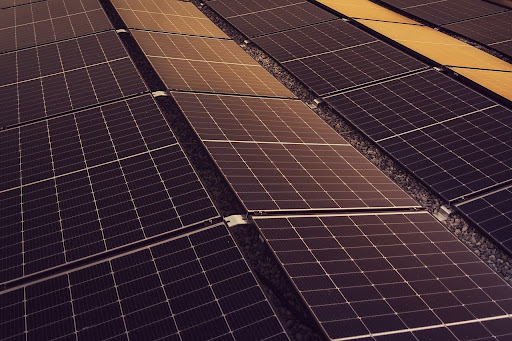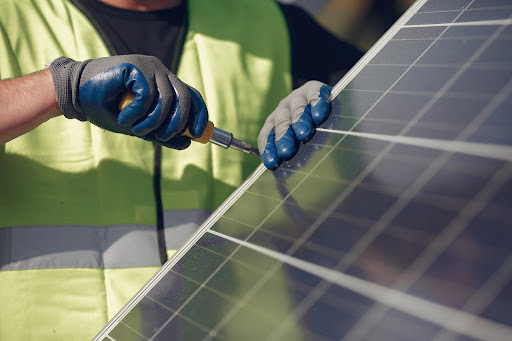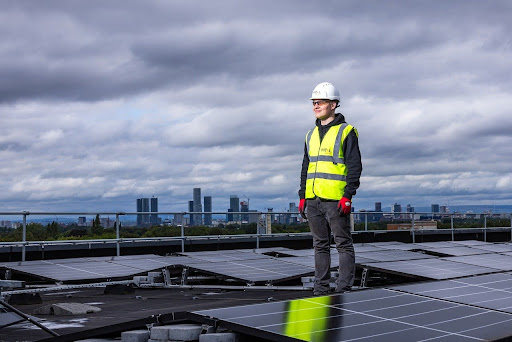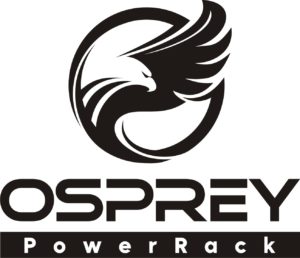Best Solar Options For Warehouses: Ground-Mount vs Rooftop
Key Takeaways
- Solar panels can significantly reduce energy costs for warehouses, with savings on electricity bills often ranging from 20% to 50%.
- Rooftop solar systems are ideal for warehouses with large, flat roofs and can be installed without major structural changes.
- Ground-mount solar panels require more space but offer higher efficiency and easier maintenance access.
- Choosing between rooftop and ground-mount solar depends on factors like available space, budget, and energy needs.
- With its earth anchor foundation, Nuance Energy’s Osprey PowerRACK® offers an efficient alternative, providing fast installation, durability, and adaptability to challenging terrains.
Solar System Types For Warehouse

Rooftop solar systems are a good choice for warehouses that receive ample sunlight.
Rooftop Solar Systems: These systems are installed directly on the roof of a warehouse. They are ideal for facilities with large, flat roofs that receive ample sunlight throughout the day. Rooftop systems are often easier to install and can be less expensive because they don’t require additional land.
Ground-Mount Solar Systems: As the name suggests, these systems are installed on the ground. They require more space but offer greater flexibility in terms of orientation and tilt, which can enhance energy capture. Ground-mount systems can also be more efficient as they are not limited by roof angle or shading issues.
| Nuance Energy is your superior solution for Ground Mount solar. Our patented foundation technology Osprey PowerRACK® allows for rapid installation using only handheld tools, significantly reducing both time and costs compared to traditional racking systems. This cutting-edge technology works for residential and commercial installations, and Nuance Energy empowers solar installers to take back control of their installation schedules, control project COGS, gain market share, increase the speed of installation, and reduce the cost of labor. In contrast, a traditional ground mount is much more unpredictable, slower, and costly.
Find out how Nuance Energy can accelerate your solar projects with the Osprey PowerRACK® line, and boost your profitability. Contact us today to discuss our innovative ground-mount solutions. |
Advantages of Rooftop Solar Systems
- Efficient Use of Space: Rooftop solar systems utilize the warehouse’s existing roof space, eliminating the need for additional land.
- Lower Installation Costs: With no need for land preparation or extra structures, rooftop installations are generally more affordable and faster to set up.
- Minimal Structural Changes: Solar panels can be directly mounted on the existing roof, avoiding complex or costly structural modifications.
- Energy Savings: Rooftop solar systems can significantly reduce electricity costs, often providing savings between 20% to 50% on energy bills.
- Less Maintenance: Rooftop systems are easy to maintain, with fewer components exposed to potential ground hazards.
Advantages of Ground-Mount Solar Panels

Ground-mount systems are more flexible and can be positioned for maximum sun exposure.
- Optimal Solar Capture: Ground-mount solar systems can be installed at the ideal tilt and orientation, maximizing energy efficiency and output.
- Easier Maintenance Access: With ground-mount systems, maintenance and cleaning are more accessible, which prolongs the system’s lifespan.
- Flexible Placement: These systems can be positioned for optimal sunlight exposure, resulting in higher energy production and greater cost savings.
- No Roof Constraints: Unlike rooftop systems, ground-mount panels are not limited by roof size or structural capacity, allowing for larger installations to meet high energy demands.
- Scalability: Ground-mount systems can easily be expanded if energy needs increase, offering long-term flexibility for warehouses.
- Higher Energy Output: With fewer limitations on panel orientation and placement, ground-mount systems can generate more electricity, making them ideal for facilities with significant energy requirements.
Comparison: Ground-Mount vs Rooftop Solar Systems

Rooftop systems have lower installation costs, but ground-mount systems can result in greater long-term savings.
Cost Comparison
Rooftop systems generally have lower upfront costs because they utilize existing roof space and require fewer additional structures. However, the cost of reinforcing the roof or addressing structural issues can add to the overall expense.
Ground-mount systems typically have higher initial costs due to the need for land preparation and mounting structures. However, they usually offer higher efficiency and energy output, which leads to greater long-term savings.
Using innovative alternatives like Nuance Energy’s Osprey PowerRACK® can significantly reduce the labor and installation costs you would see with a traditional ground mount.
| Cost Component | Estimated Range |
| Rooftop Solar System | $1.50 – $3.00 per watt |
| Ground-Mount Solar System | $2.00 – $4.00 per watt |
Efficiency and Energy Output
Ground-mount systems typically offer higher efficiency because they can be optimally oriented and tilted to capture maximum sunlight. This flexibility can lead to increased energy production, especially in areas with high solar potential.
In contrast, rooftop systems are limited by the roof’s orientation and angle. While they can still generate substantial energy, their output might not match that of a ground-mount system unless the roof is perfectly aligned with the sun’s path. Additionally, rooftop panels may experience shading from nearby structures or equipment, which can reduce their efficiency.
Long-Term Maintenance
Ground-mount systems are generally easier to access, making it simpler to perform regular maintenance tasks such as cleaning and inspections.
On the other hand, rooftop systems can be more challenging to maintain due to their location. Accessing the panels may require special equipment or safety precautions, which increases maintenance costs. However, because rooftop systems are less exposed to dust and debris, they may require less frequent cleaning compared to ground-mount systems.
How to Choose the Right Option
- Available Space: Consider the amount of roof or land space available for a solar installation.
- Budget: Evaluate the upfront costs and potential long-term savings of each option.
- Energy Needs: Assess your warehouse’s energy consumption to determine the size and capacity of the solar system required.
- Local Regulations: Check for any zoning or building regulations that may impact the installation process.
What Makes Nuance Energy’s Osprey PowerRACK® a Better Option for Warehouses?
Nuance Energy’s Osprey PowerRACK® offers a more flexible and efficient alternative to both rooftop mounts and traditional ground-mount systems for warehouses. Unlike rooftop solar, the Osprey PowerRACK® doesn’t rely on the structural integrity or size of the roof, making it a great option for warehouses with limited roof space or older buildings that may not support the weight of solar panels. Additionally, its ground-mount design allows for optimal tilt and orientation, ensuring maximum sunlight capture.
The Osprey PowerRACK® involves a concrete-free installation and uses our patented earth anchor technology. It can be installed in a single day using simple hand-held tools, eliminating the need for heavy machinery and reducing labor costs by up to 73%. This ease of installation and flexibility make it ideal for warehouses with challenging terrains, as the system can be installed in various soil conditions without the delays of geotechnical reports. Its adaptable design ensures stability in high-wind areas and makes it easier to maintain, giving warehouses a cost-effective, low-maintenance solar solution.
Ready to take the next step?
Contact our team to learn more about the product and schedule a site assessment for your project.
Frequently Asked Questions
How long does it take to install warehouse solar panels?
The installation timeline for warehouse solar panels can vary based on the system’s size and complexity. Generally, it takes between a few weeks to a couple of months to complete the installation process. This timeline includes site assessments, design, permitting, and the actual installation.
- Site Assessment: 1-2 weeks
- Design and Permitting: 2-4 weeks
- Installation: 2-6 weeks
It’s important to work with your solar installer to develop a detailed project timeline and ensure a smooth installation process.
What are the initial costs of solar panel installation?
The initial costs of solar panel installation vary widely based on factors such as system size, location, and specific project requirements. Rooftop systems tend to be less expensive due to lower structural costs, while ground-mount systems may require additional land preparation and mounting structures.
Can solar panels work in cloudy conditions?
Yes, solar panels can still generate electricity in cloudy conditions, although their efficiency may be reduced. Solar panels are designed to capture both direct and diffused sunlight, so they can continue to produce energy even when the sun isn’t shining brightly.
In regions with frequent cloud cover, it’s important to size the solar system appropriately to ensure consistent energy production.
What are some ways to reduce the installation costs for ground-mount solar panels?
Nuance Energy’s Osprey PowerRACK® reduces installation costs by eliminating the need for concrete and heavy machinery with its patented earth anchor technology. It can be installed using basic hand-held tools, cutting labor costs by up to 73%. Additionally, fewer site visits and real-time pull testing further streamline the process.
Save Time & Money on Your Next Solar Project
Request a QuoteRECENT POSTS
- DPW Solar vs Nuance Energy Mounted Solar Options: Cost & Benefits
- Geotechnical Report Cost & Requirements For Solar Projects
- Are Solar Panels Worth It In Nevada? Costs & Options
- OSPREY PowerRack Ground Mount System Compatibility: Single- and Dual-Axis Trackers
- Rammed Earth Foundation For Solar Arrays: Cost, Pros & Cons
- Agrivoltaics Explained: Solar & Agriculture Combined
- Large Scale Solar Systems Options: Pros & Cons
- Best Solar Options For Farms & Agriculture: Cost, Pros & Cons
- Unirac vs MT Solar Mounted Options: Cost & Benefits
- IronRidge vs Grengy Mounted Solar Options: Cost & Benefits

